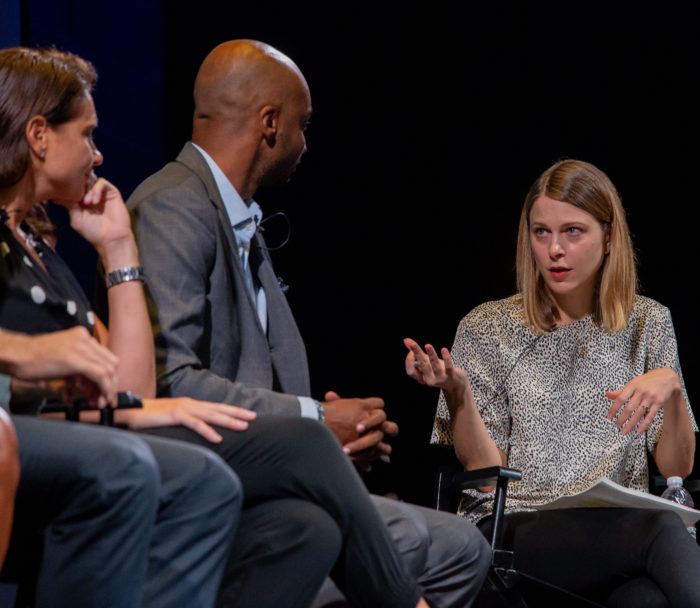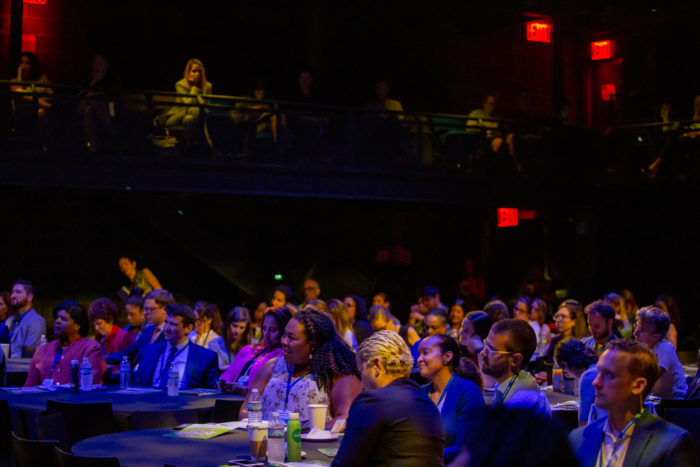Many companies have a Cyclops problem, often narrow-mindedly seeing only what’s in front of them. So then how do businesses today build diverse, inclusive, purposeful teams?
The answers come from a few different sources, according to the lively and informative panel “Building a Purposeful Team” at the From Day One conference co-presented by The Bridge, featuring experts with deep knowledge of creating diverse teams.
But let’s start with the benefits: not only do inclusive teams bring a greater breadth of knowledge and backgrounds helpful for finding solutions, but for the bean counters among us, diversity also has a significant impact on the bottom line.
Khalil Smith, practice lead of diversity and inclusion at the NeuroLeadership Institute, pointed out that diverse teams generate returns inside their organizations, highlighting that a large percentage of patents are developed by immigrants. (Research proves this out: More than one-third of individuals who have contributed to technological innovation in the U.S. are born outside the country, according to Fortune.)

Moderator Kristen Bellstrom of Fortune poses a question to Khalil Smith of the NeuroLeadership Institute
Companies that pursue diversity become more attractive to a broader array of job seekers, as well. Job candidates armed with that knowledge embrace businesses that champion diversity and tend to turn their backs on those stuck in the 20th century. “Candidates are doing the research,” said Jennifer Abbondanza, vice president of corporate initiatives for NBCUniversal’s Office of Diversity & Inclusion. “They know who gets it and are doing inclusion,” but it’s still the company’s responsibility to create an environment where people of all types feel comfortable enough to speak their mind. “That’s what is going to curate the best ideas and decision-making,” she said.
Attracting a Broad Base of Candidates
Increasing the talent pool starts with the job description, said Penda Aiken, president of leading staffing agency Penda Aiken Inc., and this is reinforced by the company mission and description. “The culture also needs to make employees feel like the company has social responsibility. It goes beyond lip service,” she said, pointing out the recent internal crisis at CBS, which saw the ousting of longtime executives. “What is the company culture and how is that being backed by leadership?”
How to Communicate Company Culture
Projecting this culture—and living by its high standards—is crucial, said David Raper, senior executive of corporate citizenship at IBM, global markets. “It starts at the top with the view of not just the company, but what sort of society are we as a company creating, internally and externally?” The next trick, then? Building processes to carry out the mission.
Harnessing Data to Make Decisions
Over at NBCUniversal, Abbondanza uses data to inform hiring culture, and works with the talent-acquisition team to research populations they want to better understand and around which they can develop strategies to counter unconscious bias.
But data, of course, isn’t the end-all, be-all. As NeuroLeadership’s Smith said, there is bias inherent in AI and technology, which is primarily created by young to middle-aged white males. The people who create AI might not know where their biases are hiding. As machines churn through data sets, even that data is consciously curated by humans. “We can’t assume that artificial intelligence or machine learning is a silver bullet or will solve for all of [these unconscious biases],” he said.
Training Against Bias
While corporate training has long had a bad reputation for being dull or boring or locking people in a room against their will, unconscious-bias training is gaining traction—and yet still more can be done.
Aiken says the diversity-recruiting process can run into a roadblock. Her staffing firm might find the best talent and arrange the interview, but ultimately the hiring manager or team decides who’s getting the gig. If hiring managers fall prey to their own biases, then “everything that’s being done to promote diversity and inclusion is for naught,” she said.

The From Day One conference drew more than 300 participants to BRIC House in Downtown Brooklyn
The challenge with difference-focused training is that it often backfires. Research shows that it can infuriate the people it’s intended to educate—white men—while highlighting differences rather than bringing people together. The counterpoint, said Smith, is to be deliberate about training and create common goals: What are you working on collectively, and what are you coming together to do? “If you have a brain, you have bias,” he said, but if you’re not aware of your biases, you can’t mitigate them.
Keeping Your Employees Happy
Moderator Kristen Bellstrom, deputy digital editor at Fortune, posed this question to the group: Even when you hire the right people, why do companies still have trouble keeping women and people of color on their teams, and what can they do to fix it?
Companies have to think beyond bean bags and cold-brew coffee, and inclusion goes beyond an open-office floor plan, said Aiken. What matters more is how people are treated. “Communication is critical,” she said. Successful companies emphasize social activity, and ask how they can contribute to the surrounding community.
During his experience at IBM and previously at Housing Works, Raper said a culture of inclusion came from the top down. “It really did matter to the CEO. They talked about it all the time, and there were clear values at each company.” Another valuable idea is to hold an open-door policy. Ultimately, it’s about transmitting this diverse thinking into the DNA of the company. “Whether you’re a CEO or a person at the company, it’s about how to bake it into your behaviors,” he said.
Abbondanza seconded the importance of communication from the top. At NBCUniversal, they have a skills-building Talent Lab and diversity elements included in their programs: “There are lot of tools in the toolkit,” she said. No one knows exactly which one is working the most, but you need to use them all.”
Busting the Old Boys’ Network
Where did you go to school? Who do you know? Are you someone I might want to get a drink with later?
While traditional job-hiring practices can lean on antiquated questions with inherent biases for wealth and background, diving into the data can take the conversation one step further. NBCUniversal creates a healthy sense of competition toward its diversity goals, said Abbondanza, by stacking up data across teams to see how each fares.
But as each panelist elaborated, the broader picture is to think about how we, as individuals, can participate in an expansion of the workforce—and beyond. Aiken noted that the primary elections, occurring the same day as the conference, will see more women of color than ever run for Senate and other political roles.
In the end, creating better teams is less about networking with the same groups, and more about creating footholds in a diverse range of other networks. And that’s what they call breaking new ground.